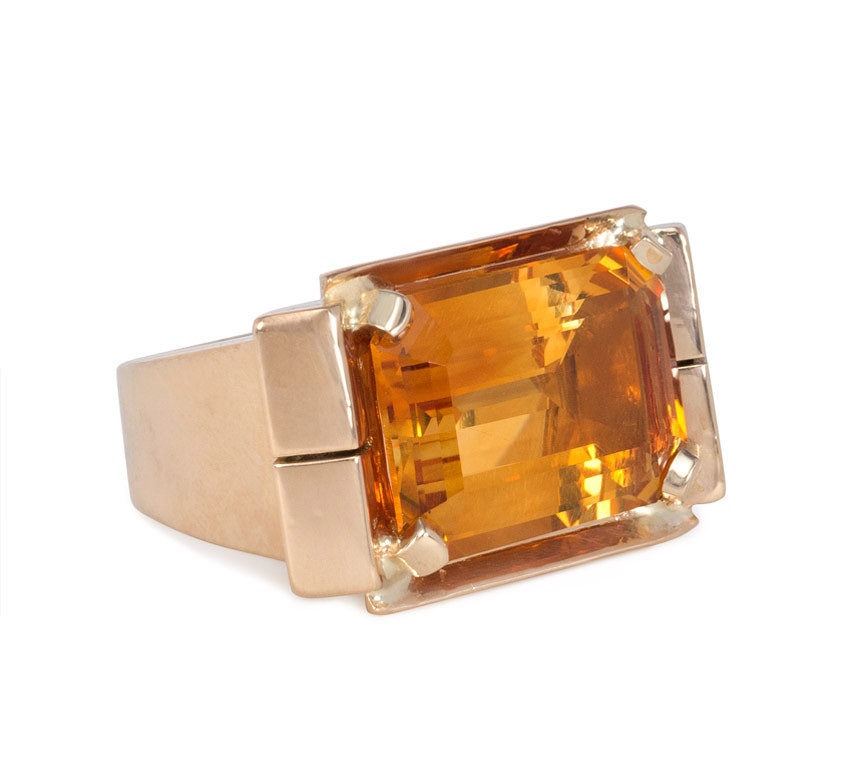WWII, Pearl Harbor, Rosie the Riveter, USO, Rationing, Women’s Army Corps, Great Depression Ends, Housing Boom, Baby Boom, Jackie Robinson, Color Television, Big Band Music, Swing Era, Zoot Suits, Bikinis all defined the 1940s.
When: 1940-1949, the first half of the decade was all about the war effort, which ended the Great Depression. The second half of the decade was about recovering from the war, a time when the economy began to boom, with houses and babies, top priorities of this newly prosperous time.
Famous Makers: Boucheron, Boivin, Cartier, Marchak, Mellirio, Sterle, Tiffany & Co., Traebert and Hoeffer Mauboussin, Van Cleef & Arpels
Motifs: Red, White and Blue, Patriotic Themes, Flags, Airplanes, Eagles, Bows, Tank Tire Treads, Flowers, Animals, Birds, Hearts, V for Victory, Ballerinas
The Look: Oversized jewelry, large colored gemstones set in gold, small stones used to create big pieces, scrolling forms, fan shapes
Materials: Topaz, Citrine, Amethyst, Aquamarine, Rubies, Sapphires, Diamonds, Rose Gold
World War II officially started in 1939, ringing in an era of austerity and gloom that lasted until 1945 when the war ended. When the war was in full swing, women were once again called upon to fill jobs in factories and offices while men were overseas. “Rosie the Riverter” epitomized the new working woman and her image was in posters everywhere encouraging patriotism. Everything was in short supply and rationing was common. There was a somberness that filtered into every aspect of life including apparel, which was much more subdued than in the previous two decades. These more restrained clothes provided the perfect backdrop for the oversized jewelry that was so in vogue. The scale of the jewelry also prompted a change in the way it was worn, unlike the previous years when layering multiple pieces of jewelry was de rigeur, it was now stylish to wear just one or two jewels — a brooch and earrings, necklace and earrings, or bracelet and brooch. Sets with two matching pieces were on trend in keeping with the “rule of two”. Rings with one large colored gemstone — often a square or rectangular shape — were featured heavily in movies, providing a touch of glamour.
Needless to say, the war had a huge impact on jewelry making and what was considered fashionable. The war made precious gems and metals difficult if not impossible to come by. Compounding the issue, many jewelry manufacturing firms were recruited to make military equipment such as components for compasses and other small items.
Platinum, gold and silver were declared strategic metals and were reserved for military use for the war effort. It was also very difficult to source diamonds and gemstones during that time as import/export rules were in flux. Jewelers had to be creative to find workarounds for these challenges. Often times, clients brought in an older piece and the gems and metal were used to create something new. Gold was in short supply so it was alloyed even more with other metals to make it go further, especially copper which gives gold the lovely rosy hue that is prominent in 1940s era jewelry.
Large colored gemstones were stylish, with one gem, or sometimes paired with other colored gems creating jewelry with an optimistic spirit that countered the glum mood brought on by the war. Patriotic themed jewelry, such as flags, or pieces made in red, white and blue stones were popular. It was difficult to find larger sizes of diamonds, rubies and sapphires, so to compensate jewelry was made using those gems as pavé to create substantial pieces.
Brooches remained a favorite jewelry item and as in earlier decades they were worn on dresses, hats, belts and shoes, while dress clips were fastened on a V-neck or square neck.
One of the most iconic jewelry trends of the 1940s is the tank bracelet, sometimes referred to as tire tread bracelets. These oversized, wide, architectural bracelets were inspired by the patterns left in the dirt by tank tires. Bracelets were a favorite adornment of the era and charm bracelets were wildly popular. They were link chains with small charms fastened to them that told the story of one’s life. And when it came to collecting charms, the more the merrier. ID bracelets were another important style with a thin gold plate flanked by a link chain.
Necklaces were not forgotten and were mostly collar length, sitting just below the throat. Beads were a favorite necklace style. Necklaces often did double duty converting to bracelets, clips or even earrings. Lockets were a favored style, especially in heart shapes, with a photo inside, it was a way of keeping a loved one who was away at war close.
When World War II ended in 1945, change was once again in the air. The mood lightened and along with that shift came a move into jewelry that was more naturalistic – flowers, bows, ribbons, scrolls, wild cats, domesticated cats, dogs, horses and especially birds were in the spotlight. Gems became more readily available as did precious metals. And in the latter half of the 1940s diamond engagement rings became a cultural imperative as mining giant De Beers created a marketing campaign geared to jump starting diamond sales that had declined during the war years.
The new found freedom and prosperity that came after the end of the war set the stage for the boom years of the 1950s.
Featured image (top of page): Retro 18-karat gold, ruby and diamond orchid clip with makers marks for Auguste Paillette, circa 1945, courtesy Friman & Stein Inc.
Authored by Amber Michelle
All jewelry featured in this blog is available on The Jewelers Circle.

